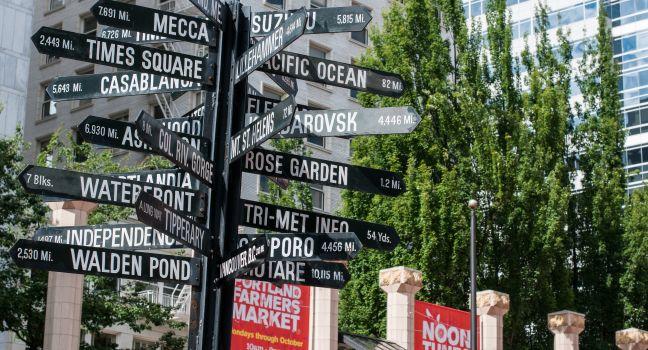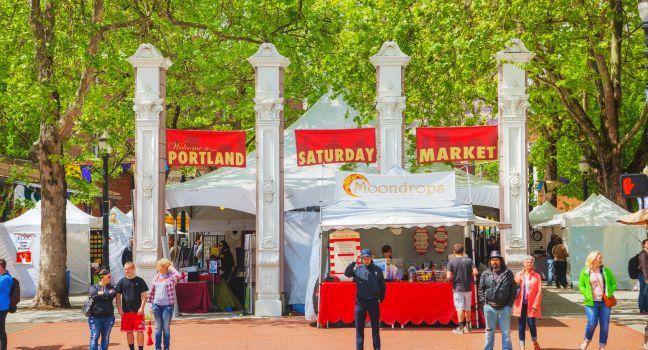Among North America’s most livable, creative, and culinarily blessed cities, leafy Portland receives plenty of recognition these days for its youthful energy, left-of-center political bent, forward-thinking urban planning and bike friendliness, and eco-minded, locavore-driven ethic. Often compared with Austin, Brooklyn’s Williamsburg neighborhood, and San Francisco’s Mission District, this city of about 600,000 teems with new residents and visitors, many of them curious to know just how accurately the cheeky indie TV show Portlandia has captured the city’s unabashedly earnest hipster vibe.
What you might miss if you focus too closely on Portland’s hipster "it" factor is that this picturesque, easy-to-navigate, midsize metropolis has plenty to offer visitors of all styles and ages—you needn’t be a devotee of artisan-roasted single-origin coffee or the finer points of urban cycling to appreciate the city’s considerable charm.
A major draw is Portland’s proximity to astounding natural scenery, from amazingly dense-wooded and tranquil forest reserves within walking distance of downtown to breathtaking coastal panoramas, snowcapped volcanoes, a thriving wine country, and a mesmerizing river gorge all within a 90-minute drive. Unless you’re in town for just a day or two, plan at least an afternoon getaway to one of these nearby oases, which also make memorable overnight getaways.
Unlike larger West Coast cities, such as Seattle and San Francisco, Portland doesn’t contain many iconic attractions: it’s a pretty but unprepossessing city with a modest but attractive skyline and a laid-back personality. Crime is low, locals are famously friendly, and most businesses and attractions cater enthusiastically to both kids and adults. It’s a fine destination for urban strolls, and it’s easy and relatively cheap to get around using public transportation (MAX light rail, streetcars, buses) and bikes. Also (you didn’t read it here), despite its eco-conscious reputation, Portland is a remarkably easy city to get around by car, with ample (and often free) street parking in many neighborhoods, especially on the East Side.
Don’t miss out on the city’s handful of terrific museums—the Portland Art Museum and Oregon Museum of Science and Industry (aka OMSI) among them. And be sure to check out some of the lovely greenery that fringes downtown, from Washington Park and Forest Park in the West Hills to tree-shaded Tom McCall Waterfront Park along the banks of the Willamette River. As you plan your visit, remember that the truly outstanding attractions in Portland are its many distinctive neighborhoods—and the indie-spirited businesses that prosper in them.
Food tourism thrives in many of these districts, which include downtown’s Pearl District and West End, and a slew of neighborhoods and commercial strips on the East Side. Spend a little time in any of these pockets, and you’ll discover critically acclaimed coffee roasters, microbreweries, urban wineries, craft distilleries, food carts, live-music halls, and both low-frills and highly ambitious restaurants. These neighborhoods, some of which retain a fiercely countercultural mindset and others that—to the disdain of purists—reflect a more gentrified and upscale tenor, also contain quite a few boutiques and shops specializing in crafts, housewares, artwork, books, fashion, and other—often handmade—lifestyle-themed goods.
Those who most appreciate Portland arrive here with a voracious appetite for new experiences, not just for innovative food and drink but also for both urban and rural adventures. The comparatively reasonable prices you’ll find in bars, restaurants, shops, and hotels (except during the increasingly pricey summer high season) are an added bonus. The inviting pedestrian- and bike-friendly cityscape and easy proximity to nature are Portland’s capstones. You could probably see the city’s must-see attractions in a day or two, but many visitors to this leafy metropolis bisected by the beautiful Willamette River—its 10 distinctive bridges themselves a popular draw—simply venture from one eclectic neighborhood to the next, constantly discovering delicious and delightful new diversions.





